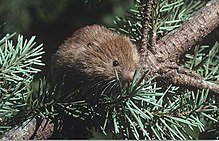Red tree vole
| Red tree vole | |
|---|---|

| |
| Scientific classification | |
| Kingdom: | Animalia |
| Phylum: | Chordata |
| Class: | Mammalia |
| Order: | Rodentia |
| Family: | Cricetidae |
| Subfamily: | Arvicolinae |
| Genus: | Arborimus |
| Species: | A. longicaudus
|
| Binomial name | |
| Arborimus longicaudus (True, 1890)
| |
The red tree vole (Arborimus longicaudus) is a rodent of the Pacific Northwest, found in the US states of Oregon and possibly California.
Description[]
The red tree vole is a rodent in the family Cricetidae.[2] It is found only in coastal forests of Oregon and northern California. They eat exclusively the needles of conifers, mostly Douglas-fir (Pseudotsuga menziesii) and occasionally other species.[3] They often spend their lives in just one tree, and many generations will live in different parts of the same tree.[4]
When eating Douglas-fir needles, they carefully remove the fine resin ducts (which resemble coarse, straight hairs) along each edge of the needle, discarding these or using them for nest lining. (see image below) They are nocturnal and very difficult to see, but they can be detected by finding piles or wads of these resin ducts on the ground.

Red tree voles are about 6-8 in long, including the tail.[4] When they are young they exhibit a dull brown coat and develop a more reddish colored coat with age.[5]
Reproduction[]
Both sexes of red tree vole display a very unusual form of niche partitioning, in that for most of the year, the females live in the trees while males live on or under the ground. During the breeding season, the males climb the trees to mate with the females, and return to the ground after the breeding season ends, leaving the females to rear offspring.[6][7][8]
Red tree voles have small litters consisting of 1 to 4 offspring and a long gestation period of 28 days compared to other Microtines. Juveniles depend on their mothers for 47 to 60 days before complete independence. Females exhibit post-partum mating where they can breed within a few days of giving birth and it is common to find two separate litters living in the same nest.[9] During peak breeding periods (winter and spring), males disperse and travel longer distances from home in search for females that are sexually receptive. Females tend to stay closer to their nests, therefore having smaller home ranges.[10]
Predation[]
The northern spotted owl is one of the red tree voles' primary predators. Recent studies show that short tailed weasels are also another primary predator of the red tree vole. Females are easier to detect by predators due to their maternal nests. The time they spend outside of their nests searching for food to bring back for their young also puts them at a higher risk of predation.[11]
Conservation efforts[]
Their habitats in old forests have become a concern for the species. Logging and habitat fragmentation has determined their status as vulnerable on the list of sensitive species on the Oregon coast.[11] They are vulnerable to timber harvest due to their arboreal lifestyle and their low reproductive rates contribute to the concern of the species becoming further threatened.[9] They are an important food source for the threatened Northern Spotted Owl and have been listed as a "survey and manage species" under the Northwest Forest Plan (NWFP) in order to help manage the area's ecosystem.[12]
| Wikimedia Commons has media related to Arborimus longicaudus. |
References[]
- ^ Scheuering, E. (2018). "Arborimus longicaudus". IUCN Red List of Threatened Species. 2018: e.T42615A22389366. doi:10.2305/IUCN.UK.2018-1.RLTS.T42615A22389366.en. Retrieved 15 November 2021.
- ^ Musser, G. G. and M. D. Carleton. 2005. Superfamily Muroidea. In Mammal Species of the World a Taxonomic and Geographic Reference (D. E. Wilson and D. M. Reeder eds.). Johns Hopkins University Press, Baltimore.
- ^ Whitaker, J. 2009. National Audubon Society Field Guide to Western Mammals.
- ^ a b "Blog".
- ^ Hayes, John P. (27 December 1996). "Aborimus Longicaudus" (PDF). American Society of Mammalogists. Mammalian Species (532): 1.
- ^ Green, Tamara. "Arborimus longicaudus (red tree vole)". Animal Diversity Web. Retrieved 2021-12-12.
- ^ "ECOS: Species Profile". ecos.fws.gov. Retrieved 2021-12-12.
- ^ Naish, Darren. "North America: land of obscure, freaky voles". Scientific American Blog Network. Retrieved 2021-12-12.
- ^ a b Miller, Mark P.; Forsman, Eric D.; Swingle, James K.; Miller, Stephanie A.; Haig, Susan M. (2010). "Size-Associated Morphological Variation in the Red Tree Vole (Arborimus longicaudus)". Northwestern Naturalist. 91 (1): 63–73. doi:10.1898/nwn09-36.1. S2CID 86157754.
- ^ Swingle, James K.; Foreman, Eric D. (2009). "Home Range Areas and Activity Patterns of Red Tree Voles (Arborimus longicaudus) in Western Oregon". Northwest Science. 83 (3): 273–286. doi:10.3955/046.083.0310. S2CID 84217641.
- ^ a b Swingle, James K.; Foreman, Eric D.; Anthony, Robert G. (2010). "Survival, Mortality, and Predators of Red Tree Voles (Arborimus longicaudus)". Northwest Science. 84 (3): 255–265. doi:10.3955/046.084.0305. S2CID 85851862.
- ^ Dunk, Jeffrey R.; Hawley, Jennifer J.V.G (24 April 2009). "Red-tree vole habitat suitability modeling: Implications for conservation management". Forest Ecology and Management. 258 (5): 626–634. doi:10.1016/j.foreco.2009.04.041.
- IUCN Red List near threatened species
- Arborimus
- Mammals described in 1890
